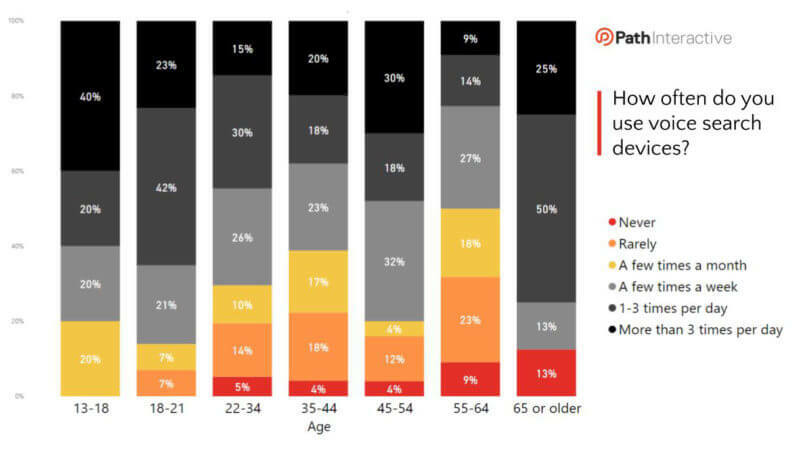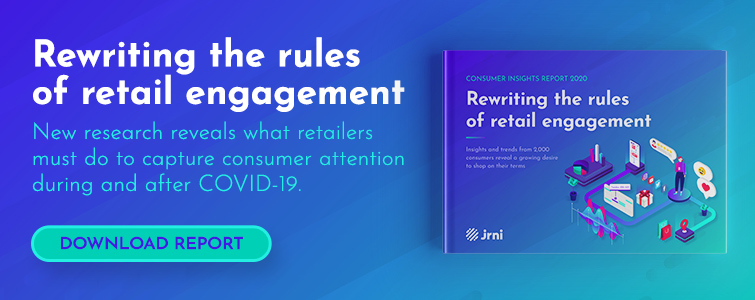30% of all searches will be done without a screen by 2020, according to Gartner. Voice search has become embedded in consumers’ daily lives for shopping, weather updates, directions, learning, and more.
“Alexa, how much is a new 40” TV?”
“Alexa, what are the best deals on Amazon today?”
“OK Google, reorder my Crest toothpaste from Target.”
These commands, or similar ones, are heard in homes around the world. In fact, 72% of people who own voice-activated speakers say that their devices are used as part of their daily routines, according to Google.
It’s clear that voice is a huge component of the future of search, but what does this mean for retail?
An overview of voice search
According to Tech Target, voice search is “a speech recognition technology that allows users to search by saying terms aloud rather than typing them into a search field.”
Voice searches can be conducted on several types of devices, including:
- Mobile devices
- Smart speakers
- Computers
- Smart watches
- Vehicles
As voice search has matured, the number of answerable search queries has also grown. Users can now use voice technology to purchase products, and make appointments or reservations.
What retailers need to know about voice shopping
Today’s retailers are looking to capture market share, increase basket size, and boost customer loyalty. Voice search can help by increasing revenue, driving in-store traffic, and fostering a better customer experience.
Consumers can use voice search to easily order products, but not all shoppers will want to make purchases right away. If a consumer isn’t ready to purchase, they may still be interested in learning more about the product from a skilled staff member. Voice technology can also be used to schedule in-store appointments with expert staff to discuss the product in more depth. An increasing number of retailers are implementing appointment scheduling software to manage these services, like personal shopping and product consultations.
Though there is no immediate sale, retailers still benefit from offering the customer the ability to learn more in-store. When shoppers go into stores, they spend more than online shoppers.
- 64% of JRNI survey respondents said they typically spend or invest more in products/services after an in-person appointment or face to face meeting.
- 71% of consumers spent $50 or more when shopping in store, compared to just 54 percent who shopped online, according to First Insight.
Voice search also improves the customer shopping experience. As voice technology rises in popularity, consumers are embedding this into their daily lives. VoiceBot.AI asked why shoppers like using voice technology to shop, and consumers said:
- 27.3% like that it’s a hands free technology
- 20.7% enjoy that they can shop while doing other things
- 18.9% find that it’s faster to get results and answers
Ultimately, retailers must meet consumers where they are. According to Forbes and PwC, 40% of adults use voice search on a daily basis, and 80% of consumers report satisfaction with the voice shopping experience.
How do shoppers use voice search?
Voice technology helps consumers research, buy, and track purchases.
In fact, close to 50% of people are now researching products using voice search, according to Social Media Today. Stores like REI, B&H Photo, Best Buy, and Levi’s have created Alexa “skills” for consumers who own Amazon Echo devices. Retail brands are creating these skills – similar to apps – to help customers better interact with their brand and products using voice technology. Using the Levi’s skill, consumers can ask Alexa to locate their nearest store, find a pair of jeans, and get information on their return policy.
Consumers purchase these items the most through voice shopping, according to a study from VoiceBot.AI:
- Everyday household items: 25.11%
- Apparel: 21.15%
- Entertainment like movies and music: 21.15%
- Games: 18.94%
After purchasing products, shoppers can use Alexa to track their package. Alexa and similar voice technology has officially made its way into the consumer shopping process from research to delivery.
How to prepare for voice search
In an ideal world, a retail brand would perform well for all queries – branded and non-branded searches, and for short-tail and long-tail keywords. However, that’s no easy feat.
When asked how businesses can prepare for the rise of voice search, Google’s Webmaster Trends Analyst John Mueller said: “I think for the most part if you make a website such that the information is easily accessible and useful for search engines and for users as well, then you don’t need to do anything special for voice.”
Ultimately, optimizing for voice falls under search engine optimization, which is a key component of any marketing strategy. Given that, there’s still a few things to keep in mind:
Consider the audience
How important is voice search to different demographics? Path Interactive recently surveyed 620 people ages 13-85 about how they use voice technology. Here’s what they found:

Combine that with VoiceBot.AI’s data on what consumers purchase the most using voice, and you’ll have an understanding of who uses voice shopping and what they purchase.
Voice search optimization
When it comes to voice search optimization, Mueller mentions that businesses should focus on having an accessible and easily understood website. Marketing and development teams should use Google’s Developer Documentation to ensure the proper schema markup is added to the site. At the end of the day, voice is simply another way of accessing a search engine. What search engines prioritize is useful, organized content.
Want to learn about new and changing consumer behavior? Be sure to check out our recent research "Rewriting the rules of retail engagement" to learn more.




